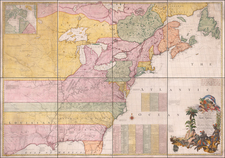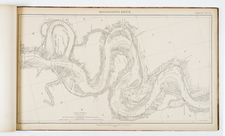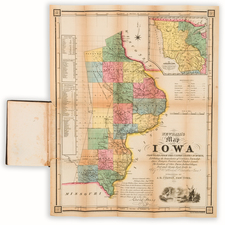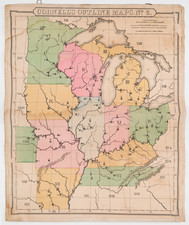A Hidden Cartographic Gem -- The Earliest Printed Map To Depict the Escalante-Dominguez Expedition of 1776, with Highly Accurate Information in Colorado, Texas and California
Rare map of Mexico, Texas, Upper California and contiguous regions, published in Spain at the beginning of the 19th century.
While virtually unknown until recent years, the map is an extraordinarily well researched map, incorporating for the first time manuscript information available only in the Spanish Archives. The following is drawn from an unpublished essay on the map written in 2017 by Dirk Depagter:
Corradi's Carta Esferica del Reyno de Mexico . . . is a map of extraordinary importance, integrating for the first time on a printed map the latest Spanish cartographic and hydrographic information available for the western slope of Colorado and significant parts of the American Southwest. The information in Corradi's map is clearly is drawn directly from Bernardo de Miera y Pancheco's 1778 manuscript map Plano de la Provinca Interna de el Nuevo Mexico, which was drawn from information derived from the Escalante-Dominguez expedition in 1776. In particular the Rio Dolores, with its prominent bend and the Rio San Juan (Rio Navajo) and its tributaries are drawn from the Mier y Pacheco. Corradi's map also reproduces the error that Miera y Pacheca made in showing the Rio Buanaventura (the Green River) running into Sevier Lake instead of the Colorado River.
What makes Mier's map extraordinary is that there is no other printed map which incorporates the information from the Escalante-Domingues expedition, etc. prior to the publication of Baron Von Humboldt's landmark Carte Generale du Royaume de la Nouvelle Espagne . . . , which was first printed in 1811. Moreover, Humboldt's portrayal of the Miera's cartographic information is inferior to the Corradi map.
Depagter's research demonstrated that Corradi had access to the latest cartographic information in Madrid including Carta Esferica que Comorehende Las Costas Del Seno Mexicano, published in Madrid in 1799 by secretaria del Estado y de la Marina, generally regarded as the most important Spanish charting of the Gulf of Mexico in the 18th Century. Corradi also incorporates information from the Miguel Costanzo's Carta Reducida del Oceano Asiatico" of 1771 for its depiction of the California coast.
On the California coast, Corradi's map shows the San Francisco bay area and the Sacramento River (Rio de Los Dolores) in a remarkably accurate manner for the time, however the Sacramento River is shown to penetrate the Sierra Nevada. Also shown is the Rio Carmelo and R.S. Felipe, incorrectly penetrating much of central California.
In Southern California, the Mohave River (R. de Los Martiers) is not portrayed accurately and is shown as flowing into the Colorado River. Depagter notes that Corradi may have incorrectly labeled the Virgin River that does drain in to the Colorado and at that time was known as R. de Las Pyramides. The Gila River is fairly accurate with Tucson (Tubson) located to far east with a fictitious lake to the North.
Further East, the Rio Grande is depicted and named, while the Rio Pecos is shown but not named. In the Big Bend area, the name Parral appears. it is possible that this is a mislocation of the town of Parral, which was founded around a silver strike in 1631 and/or the location of one of the five defensive points set up by the Spanish to defend against the Apache's dating to the 1690s.
Going up the coast from the mouth of the Rio Grande we first encounter R. de Las Nueces (The Nueces River). Next we have two unnamed rivers coming out of a bay. These are probably the San Antonio and Guadalupe Rivers further north named the Rio Flores. San Antonio appears to be located but not named. The Rio Colorado, de Nachitos o de Las Canas is shown. An unnamed Trinity River is shown to be flowing into B. de Galveston (Trinity and Galveston Bays) the next river is named R. Alibanos (Neches River). On this river is a town named Cenis, the place named generally credited as the earliest naming of Texas. On De L'isle's map of 1718 it appears as a prominent town with a note stating "Mission de Los Teijas Esjablie en 1716". The last river before the Mississippi is called the Rio Apalachicola and must be the Sabine River. A place name of Adaza is shown, this maybe Nacogdoches (Natchitoches).
The Mississippi Delta is depicted with good detail. Going up the Mississippi we have the Rio Roxo this of course is the Red River with the Rio Negro, Black River flowing into it. Further up the Rio Arkansas is grossly understated. Next is the Rio Blanco, White River.
The Missouri River is named twice as R. Misuris and Misurio. The Kansas River is named Rio Puducas and a Peducas Village is shown. This map does not solve the mysteries of the southeast Rockies and planes drainage via the Arkansas and Canadian rivers, this will be up to the next generation and a new country.
The following is a survey of the other major maps of Mexico and the Southwest from the 18th century:
- 1729 Manuscript map by Barreiro "Plano Carographico e Hydrographico de las provinces de el Nuevo Mexico" ( see Paul E. Cohen's mapping the west)
- 1768 printed map by: Joe Antonia de Alzate y Ramierez" Nuevo Mapa Geographico de la America septentrional, pertenecienta al virreynato de Mexico" (Barry Ruderman archive Inventory # 31332 RG)
- 1771 The above mentioned manuscript Miguel Costanco Map
- 1778 The above mentioned manuscript Miera map
- 1799 The above mentioned Gulf of Mexico map
Corradi's map is almost certainly the second printed map of the southwest after the Alzate map of circa 1768 and the only map to incorporate Mier y Pacheco's information from the Escalante-Domingues Expedition. Moreover, it is superior to Humboldt's map, predating it by nearly a decade and utilizing more accurate and advanced information of the lower western Rockies.
Rarity
The map is quite scarce on the market. This is the second example we have offered in over 20 years.











![(Humboldt Atlas and Text) Geographique et Physique du Royaume de Nouvelle-Espagne [with quarto text:] Essai Politique de la Royaume de la Nouvelle-Espagne](https://storage.googleapis.com/raremaps/img/small/99796.jpg)


